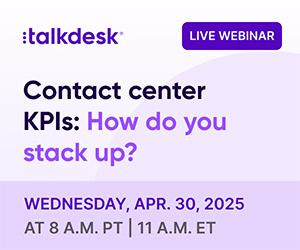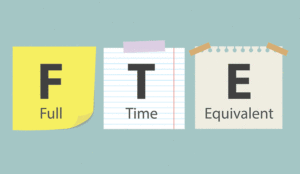Celia Cerdeira at Talkdesk discusses what an inbound contact centre is, the differences between inbound vs outbound contact centres, how inbound contact centres work, important customer experience metrics, and more.
When customers have a problem, where do they turn? Picture a frustrated customer reaching out for help, their confidence restored the moment they connect with the inbound contact centre – where skilled agents turn potential frustration into customer satisfaction.
Today’s customers have high expectations, so an inbound contact centre needs to be firing on all cylinders.
Inbound contact centre software that relies on advanced technologies like artificial intelligence (AI) can streamline communication processes, optimize agent workflows, and ultimately increase customer satisfaction and loyalty.
The right inbound contact centre software can help agents stay on top of all the calls, emails, messages, and social media communications.
What Is an Inbound Contact Centre?
An inbound contact centre is a specialized hub where agents receive and handle calls, texts, emails, or chats initiated by customers.
Customers often seek technical support or customer service. They may need assistance placing orders, resolving payment issues, finding answers to their billing questions, returning a product, changing their account password, repairing a malfunctioning product, or upgrading, renewing, or cancelling a subscription-based service.
Inbound Contact Centre vs Inbound Call Centre: What’s the Difference?
Many use the terms inbound contact centre and inbound call centre interchangeably, but the two are a little different.
Both involve agents who answer and respond to customers’ inquiries, but inbound call centres simply field requests from customers who reach out over the phone.
In contrast, inbound contact centres are responsible for responding to customers who initiate contact via email, live chat, social media, and phone.
They handle inbound communication across a variety of channels, whichever the customer finds most convenient.
How Is an Inbound Contact Centre Different From an Outbound Contact Centre?
While inbound contact centres handle incoming customer inquiries, outbound contact centres are responsible for placing outgoing calls and messages.
Inbound contact centres deal with incoming customer service requests. On the other hand, outbound contact centres initiate contact with customers or potential customers.
For example, an outbound contact centre might focus on telemarketing, lead generation, customer satisfaction surveys, market research, and proactive customer service to gather information, prompt products or services, or improve customer engagement and satisfaction.
How Does an Inbound Contact Centre Work?
Inbound contact centres serve as hubs where trained agents receive and respond to customer inquiries. Their ultimate goal is to provide efficient customer support and handle customer issues.
Modern inbound contact centre software uses generative AI, virtual agents, and real-time metrics to enhance customer service.
Generative AI Transforms Customer Service
In the past, customers might spend several minutes navigating through interactive voice response (IVR) systems.
These automated phone trees answered incoming calls and prompted callers to select options by pressing designated buttons.
IVRs offer an impersonal and often frustrating experience compared with how generative artificial intelligence is now transforming customer service.
Not only does generative AI go beyond the basic script IVRs were limited to, but it also offers hyper-personalized interactions.
After all, generative AI can understand human language and even analyze customer emotions. Other generative AI use cases in inbound contact centres include automatic interaction summaries, sentiment analysis, personalized responses to reviews, and training materials designed for a specific agent’s skill set and training needs.
Virtual Agents Offer 24/7 Support
Some inbound contact centres also use virtual agents driven by artificial intelligence and scripted rules. These bots are available 24/7 over phone calls or live chat to assist customers with everything from order status updates to cancellations.
Virtual agents can also help refund requests, answer questions, provide information on products and services, and even escalate the inquiry to a live agent when necessary.
They allow customers to access the service they need on their own timeline without depending on human agent availability.
Having virtual agents manage repetitive, easy-to-resolve inquiries gives agents more time to handle complicated issues.
Ultimately, virtual agents can help reduce costs, wait times, and resolution times across an inbound contact centre while improving customer satisfaction.
Real-Time Metrics Help Agents Make More Informed Decisions
Inbound contact centres also often provide real-time agent dashboards detailing various insightful metrics to help agents make informed decisions.
A real-time metrics dashboard might display:
- Service level: Contact centre service level is the percentage of queries answered within a specific time frame. It indicates how accessible and efficient an inbound contact centre is to customers. Strive for a service level of 80/20, or 80% call acceptance, with an average answering speed of 20 seconds.
- Average wait time: The average wait time refers to how long customers wait for an agent to answer their call.
- Average handle time: This is the average amount of time agents take to answer and resolve customers’ requests. It factors in delays, hold times, and actions necessary to meet customer needs. Reducing average handle time is often a top priority for inbound contact centres.
The number of available agents: A real-time metrics dashboard can also show how many agents are currently available at a glance.
When contact centre managers can access these customer experience metrics in real time, they can make swift, data-driven decisions that positively influence customer service quality.
For example, if a contact centre manager can see the real-time service level on their dashboard, they can adjust staffing during peak times or whenever the service level falls short.
Similarly, having insights into the number of available agents enables managers to distribute workloads more evenly, ensuring that customers receive the attention they need as quickly as possible and agents aren’t overwhelmed.
Which Metrics Do Inbound Contact Centres Measure?
An inbound contact centre should deliver optimal customer service—and that means tracking specific metrics.
These key performance indicators (KPIs) can provide vital insights into agent productivity, customer satisfaction, and more.
Beyond the metrics mentioned in the previous section, other important KPIs inbound call centres should track include:
Agent Status
See whether an agent has listed themselves as available, on a call, after-call work, offline, or away, which can provide insights into a team’s productivity for help optimizing workflows and staffing levels.
Average Abandonment Rate
An average abandonment rate quantifies how often callers terminate the call after being placed in a queue. This is expressed as a percentage.
Average Handle Time
Average handle time, or AHT, can help organizations determine agent efficiency. Find this by totaling the talk time, hold time, and after-call work an agent does and dividing it by the number of calls handled.
Average Hold Time
Average hold time is the amount of time customers spend on hold during a call with an agent. Hold time refers to the duration a customer spends on hold after initially connecting with an agent, such as during transfers or when an agent seeks additional information.
Average Speed to Answer
The average speed to answer (ASA) is the amount of time it takes for an agent to answer an inbound call. This includes the time when the agent’s phone rings. However, it doesn’t count the time the caller spent queuing or interacting with the IVR system.
Average Talk Time
The average talk time (ATT) is the amount of time an agent spends chatting with customers, although it excludes additional agent activities necessary to complete the interaction, such as entering data, reviewing customer history, or consulting with supervisors.
Call Disposition Codes
Agents can assign these tags to calls to describe everything from call type to outcome. Call disposition codes can also describe a call’s reason and desired after-call action. Analyzing these codes can provide a quick snapshot of an agent’s success and efficiency.
Total calls
This refers to the total number of calls an agent handles within a given period.
First Call Resolution
In a best-case scenario, a customer’s issue is resolved during their initial contact with the support team. This not only increases customer satisfaction but also reduces the workload on agents, meaning they’ll have more time to help other customers.
Calculate the first call resolution KPI by dividing the total number of calls resolved correctly on the first try by the total number of first calls or by dividing the total number of calls resolved correctly on the first try by the total number of calls in a given timeframe.
Service Level
Service level can show how readily available an inbound contact centre is to its customers. It’s typically the percentage of calls answered within a predefined threshold.
Monitoring these metrics offers valuable insights into agent productivity, customer experience, and the overall efficiency of an inbound contact centre. Use this information to make informed decisions about everything from staffing to workflow optimizations, helping to improve optimizations and exceed customer expectations.
Improve the CX With an Inbound Contact Centre Solution
The customer experience is vital, and with 67% of customers expecting a resolution within three hours, contact centre managers must do everything they can to provide an efficient and seamless experience.
A high-quality inbound contact centre can significantly enhance customer satisfaction by ensuring quick, effective responses to inquiries and issues.
This blog post has been re-published by kind permission of Talkdesk – View the Original Article
For more information about Talkdesk - visit the Talkdesk Website
Call Centre Helper is not responsible for the content of these guest blog posts. The opinions expressed in this article are those of the author, and do not necessarily reflect those of Call Centre Helper.
Author: Talkdesk
Published On: 19th Aug 2024 - Last modified: 13th Jan 2025
Read more about - Guest Blogs, Celia Cerdeira, Talkdesk






 Talkdesk is a global customer experience leader for customer-obsessed companies. Our contact center solution provides a better way for businesses and customers to engage with one another.
Talkdesk is a global customer experience leader for customer-obsessed companies. Our contact center solution provides a better way for businesses and customers to engage with one another. 












